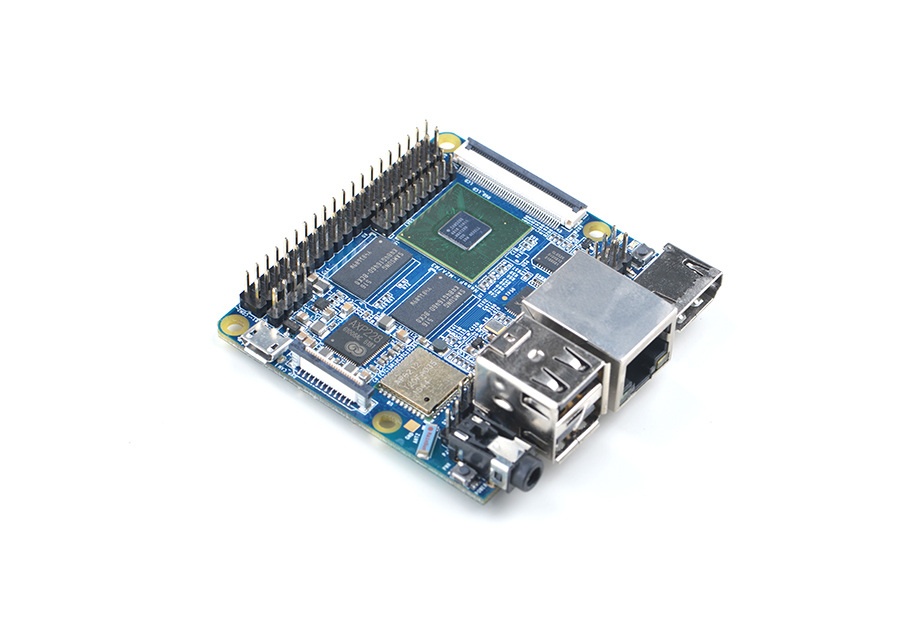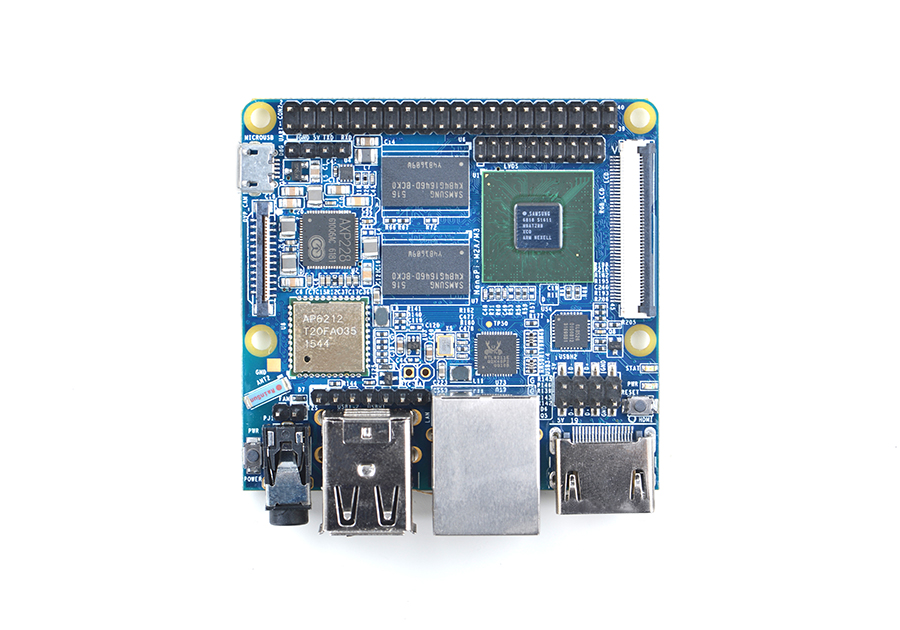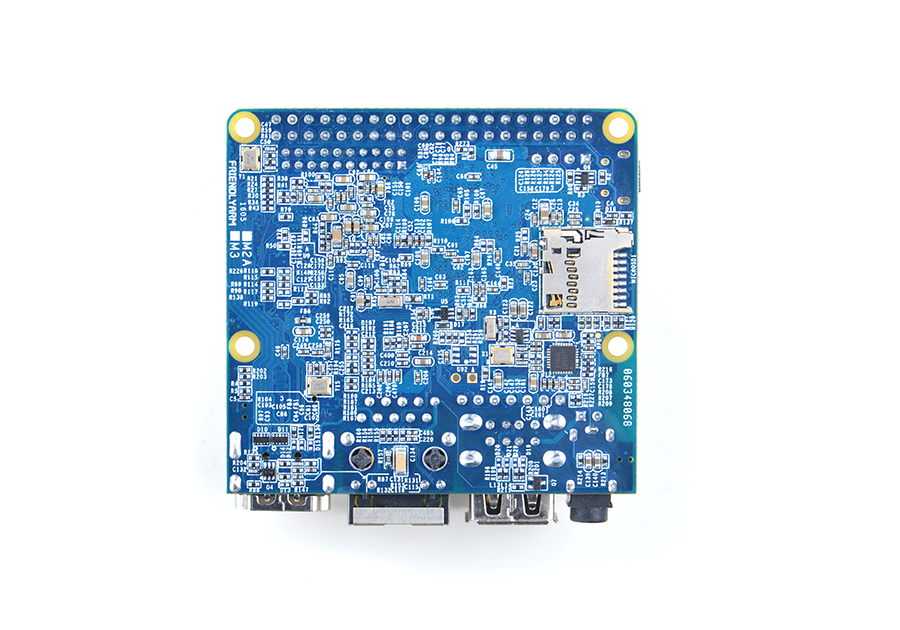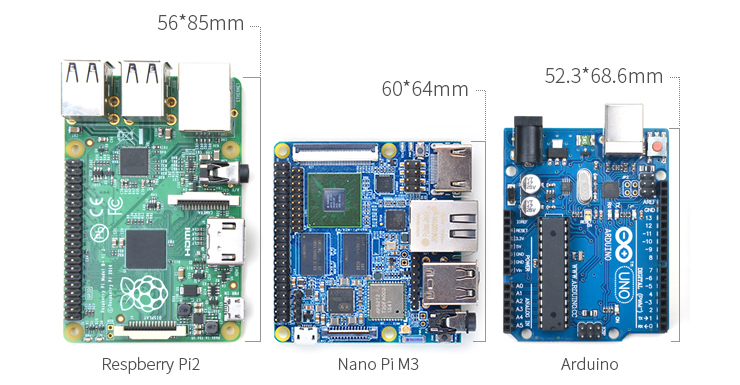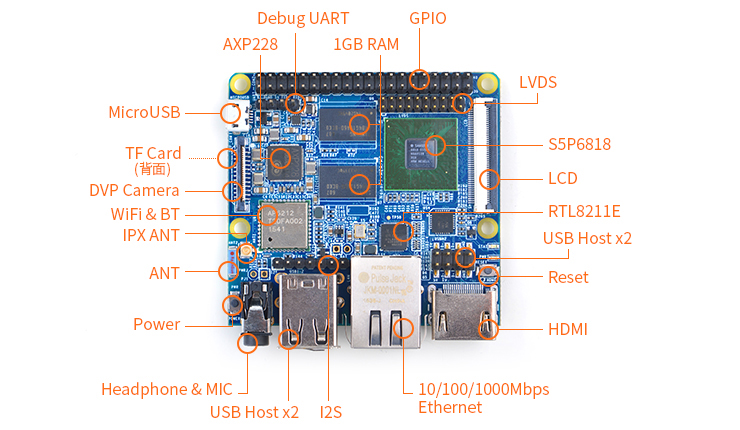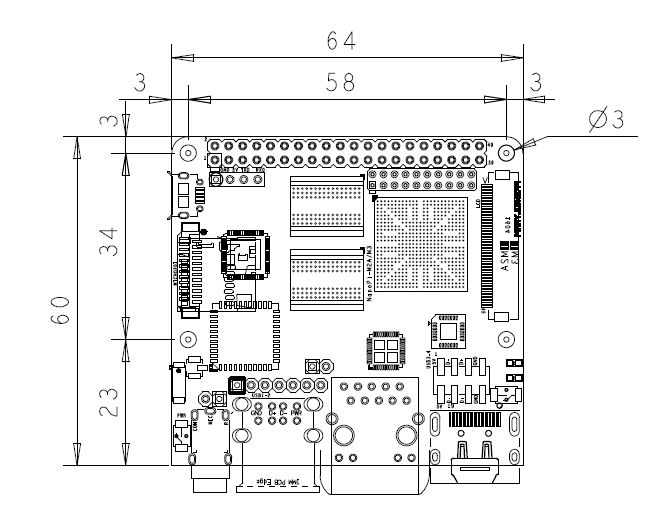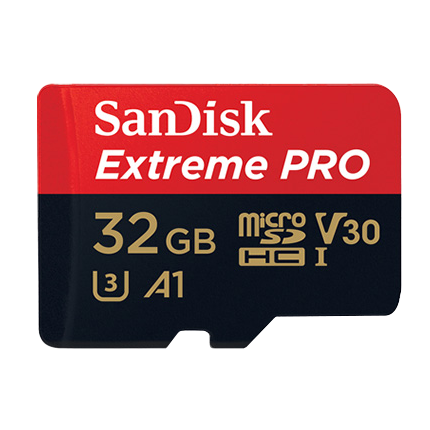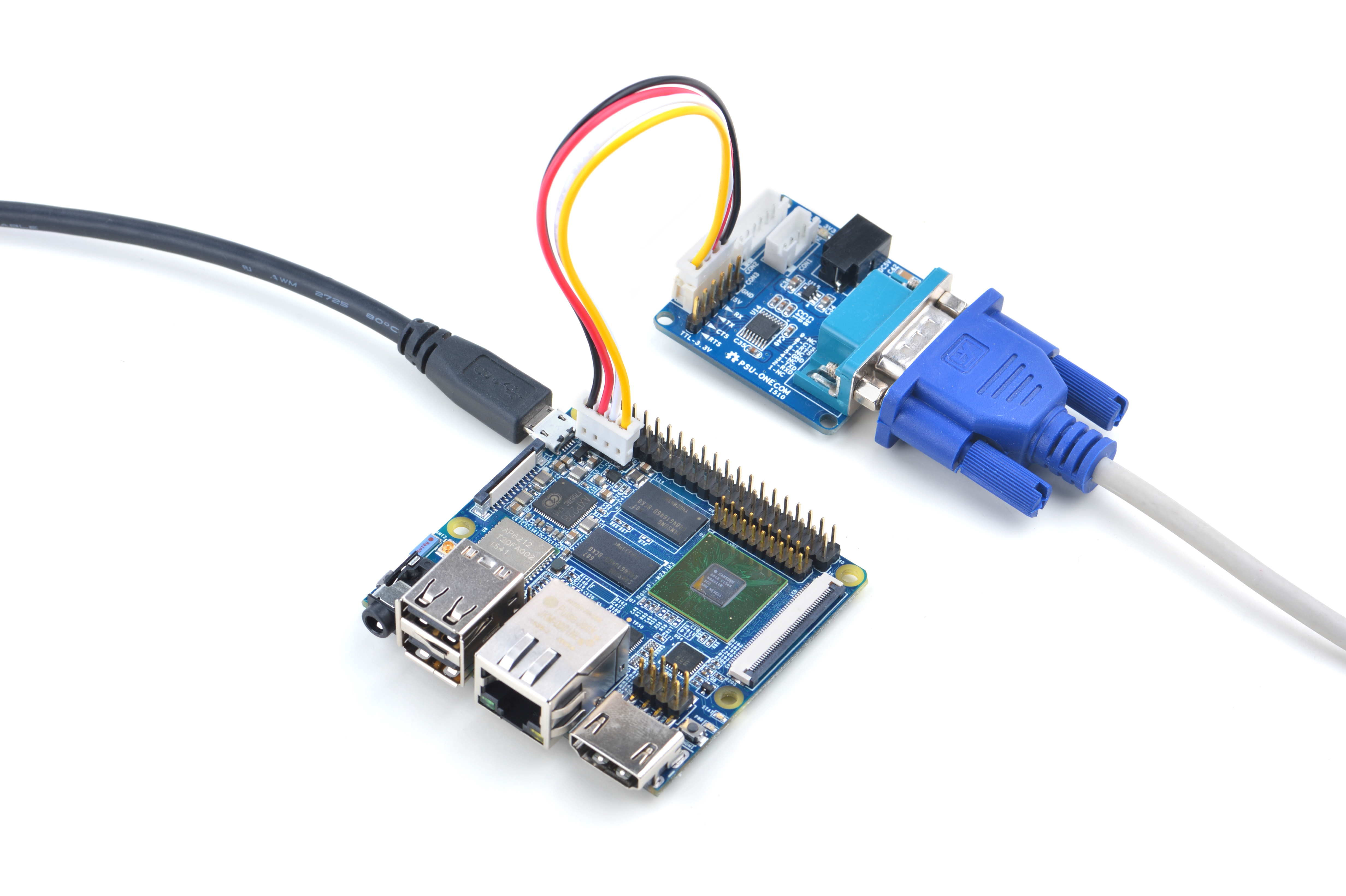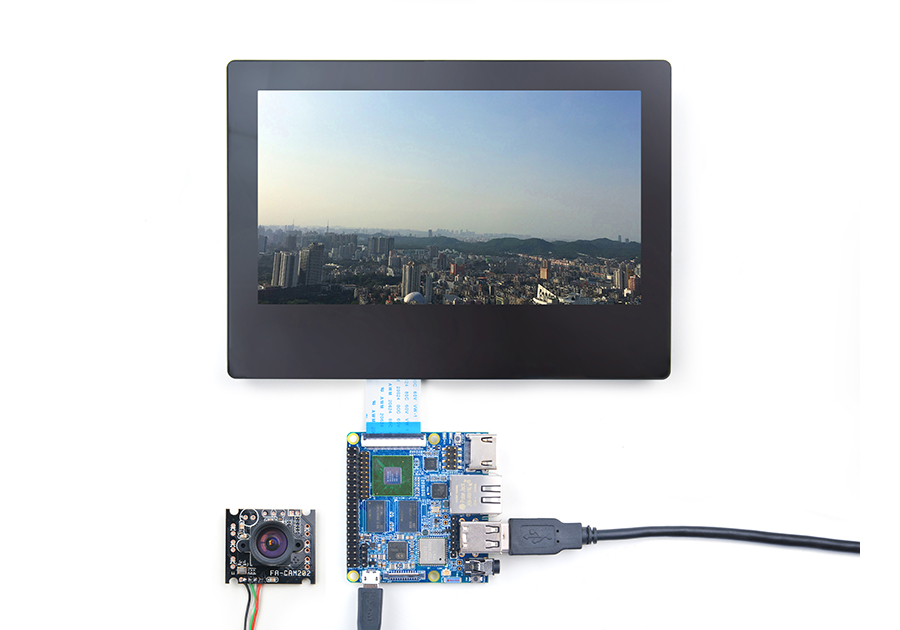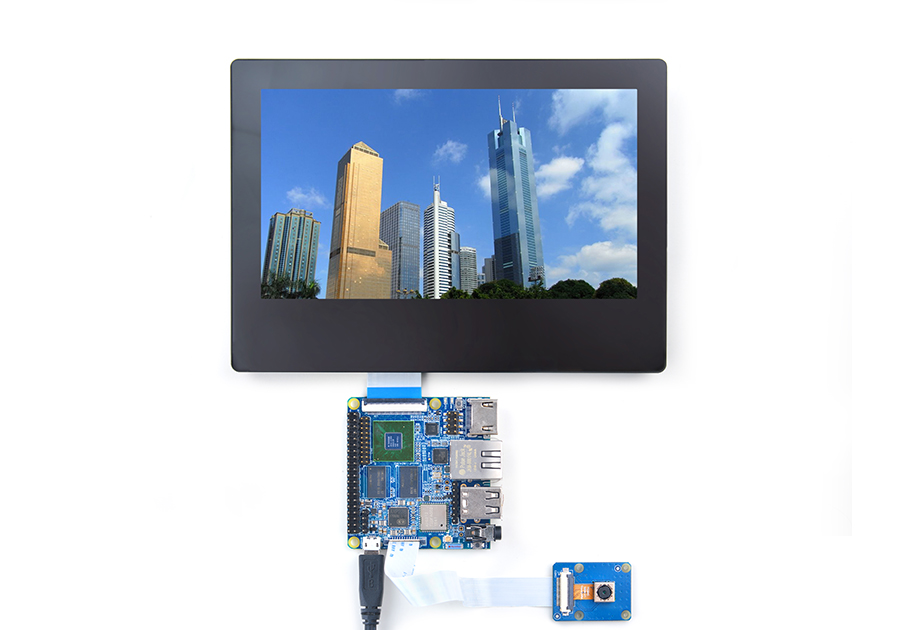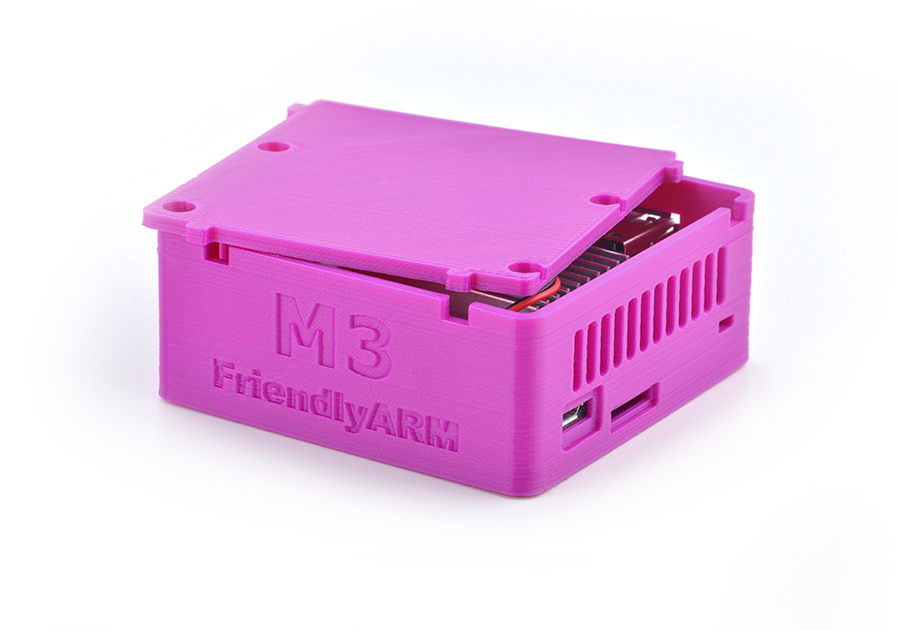Difference between revisions of "NanoPi M3"
(→在Linux Desktop下通过脚本制作) |
(updated by API) |
||
| (81 intermediate revisions by 5 users not shown) | |||
| Line 1: | Line 1: | ||
| − | [[ | + | [[NanoPi M3/zh|查看中文]] |
==Introduction== | ==Introduction== | ||
| − | [[File:NanoPC-M3- | + | [[File:NanoPC-M3-new1.jpg|thumb|Overview]] |
| − | [[File:NanoPC-M3- | + | [[File:NanoPC-M3-new2.jpg|thumb|Front]] |
| − | [[File:NanoPC-M3- | + | [[File:NanoPC-M3-new3.jpg|thumb|Back]] |
| − | * The NanoPi M3 is another ARM board developed by FriendlyARM for makers, hobbyists and hackers | + | * The NanoPi M3 is another ARM board developed by FriendlyARM for makers, hobbyists and hackers. |
* The NanoPi M3 uses the Samsung Octa-Core Cortex-A53 S5P6818 SoC. Its dynamic frequency scales from 400M up to 1.4GHz. It has Gbps Ethernet port, built-in WiFi and Bluetooth. Its AXP228 PMU supports software power-off, sleep and wakeup functions. In addition the NanoPi M3 has MicroUSB port for power supply and on-board porcelain antenna. | * The NanoPi M3 uses the Samsung Octa-Core Cortex-A53 S5P6818 SoC. Its dynamic frequency scales from 400M up to 1.4GHz. It has Gbps Ethernet port, built-in WiFi and Bluetooth. Its AXP228 PMU supports software power-off, sleep and wakeup functions. In addition the NanoPi M3 has MicroUSB port for power supply and on-board porcelain antenna. | ||
* On this tiny board various ports and interfaces are integrated. It has DVP Camera/LVDS/HDMI/LCD interfaces, Gbps Ethernet, I2S, 3.5mm audio jack, four USB ports and a serial debug port. | * On this tiny board various ports and interfaces are integrated. It has DVP Camera/LVDS/HDMI/LCD interfaces, Gbps Ethernet, I2S, 3.5mm audio jack, four USB ports and a serial debug port. | ||
| − | == | + | ==Hardware Spec== |
* SoC: Samsung S5P6818 Octa-Core Cortex-A53, 400M Hz - 1.4G Hz | * SoC: Samsung S5P6818 Octa-Core Cortex-A53, 400M Hz - 1.4G Hz | ||
| − | * Power Management | + | * PMU Power Management: Implemented by a Cortex-M0 MCU, support software power-off, and RTC alarm power-on functions |
* System Memory: 1GB 32bit DDR3 RAM | * System Memory: 1GB 32bit DDR3 RAM | ||
* Storage: 1 x MicroSD Card Socket | * Storage: 1 x MicroSD Card Socket | ||
| Line 17: | Line 17: | ||
* WiFi: 802.11b/g/n | * WiFi: 802.11b/g/n | ||
* Bluetooth: 4.0 dual mode | * Bluetooth: 4.0 dual mode | ||
| − | * Antenna: | + | * Antenna: onboard porcelain antenna for WiFi and Bluetooth |
* Audio: 3.5 mm audio jack / via HDMI | * Audio: 3.5 mm audio jack / via HDMI | ||
* I2S: 7pin, 2.54mm pitch pin-header | * I2S: 7pin, 2.54mm pitch pin-header | ||
| − | |||
* USB Host: 4 x USB 2.0 Host, two type A ports and two 2.54 mm pitch pin-headers | * USB Host: 4 x USB 2.0 Host, two type A ports and two 2.54 mm pitch pin-headers | ||
* MicroUSB: 1 x MicroUSB 2.0 Client, Type A | * MicroUSB: 1 x MicroUSB 2.0 Client, Type A | ||
| Line 31: | Line 30: | ||
* User Key: K1 (power), Reset | * User Key: K1 (power), Reset | ||
* LED: 1 x power LED and 1 x status LED | * LED: 1 x power LED and 1 x status LED | ||
| − | * RTC Battery: RTC Battery | + | * RTC Battery: RTC Battery Header |
| − | + | ||
* Power: DC 5V/2A | * Power: DC 5V/2A | ||
| − | * PCB: | + | * PCB: 8 Layer, ENIG |
* Dimension: 64 mm x 60 mm | * Dimension: 64 mm x 60 mm | ||
| + | * Temperature measuring range: -30℃ to 80℃ | ||
* OS/Software: uboot, Android and Debian | * OS/Software: uboot, Android and Debian | ||
[[File:NanoPi M3-B03.png|frameless|500px|compact]] | [[File:NanoPi M3-B03.png|frameless|500px|compact]] | ||
| Line 41: | Line 40: | ||
==Diagram, Layout and Dimension== | ==Diagram, Layout and Dimension== | ||
===Layout=== | ===Layout=== | ||
| − | [[File:NanoPC-M3-1512B-IF- | + | [[File:NanoPC-M3-1512B-IF-001.png |thumb|600px|NanoPi-M3 Layout]] |
* '''GPIO Pin Spec''' | * '''GPIO Pin Spec''' | ||
| Line 170: | Line 169: | ||
::#VDD_5V: 5V power input/output. The input range is 4.7V ~ 5.6V | ::#VDD_5V: 5V power input/output. The input range is 4.7V ~ 5.6V | ||
::#All pins are 3.3V, output current is 5mA | ::#All pins are 3.3V, output current is 5mA | ||
| − | ::#For more details refer to the document: [http://wiki. | + | ::#For more details refer to the document: [http://wiki.friendlyelec.com/wiki/images/a/ac/NanoPi-M2A-M3-1712-Schematic.pdf NanoPi-M2A-M3-1712-Schematic.pdf] |
===Board Dimension=== | ===Board Dimension=== | ||
[[File:NanoPi M3_1512B_Dimensions.png|frameless|500px|NanoPi M3 Dimensions]] | [[File:NanoPi M3_1512B_Dimensions.png|frameless|500px|NanoPi M3 Dimensions]] | ||
| − | ::For more details refer to the document:[http://wiki. | + | ::For more details refer to the document:[http://wiki.friendlyelec.com/wiki/images/9/9c/NanoPi-M2A-M3-1604-pcb-dxf.zip PCB dxf file] |
==Get Started== | ==Get Started== | ||
| Line 181: | Line 180: | ||
Before starting to use your NanoPi M3 get the following items ready | Before starting to use your NanoPi M3 get the following items ready | ||
* NanoPi M3 | * NanoPi M3 | ||
| − | * | + | * microSD Card/TFCard: Class 10 or Above, minimum 8GB SDHC |
| − | * A | + | * microUSB power. A 5V/2A power is a must |
* HDMI monitor or LCD | * HDMI monitor or LCD | ||
* USB keyboard, mouse and possible a USB hub(or a TTL to serial board) | * USB keyboard, mouse and possible a USB hub(or a TTL to serial board) | ||
| − | * A host computer running Ubuntu | + | * A host computer running Ubuntu 18.04 64 bit system |
| + | |||
| + | {{TFCardsWeTested}} | ||
===Make an Installation SD Card=== | ===Make an Installation SD Card=== | ||
====Boot NanoPi M3 from SD Card==== | ====Boot NanoPi M3 from SD Card==== | ||
| − | Get the following files from [http:// | + | Get the following files from [http://download.friendlyelec.com/nanopim3 the download link] to download necessary files:<br /> |
* Get a 4G SDHC card and backup its data if necessary.<br /> | * Get a 4G SDHC card and backup its data if necessary.<br /> | ||
::{| class="wikitable" | ::{| class="wikitable" | ||
|- | |- | ||
| − | |colspan=2| | + | |colspan=2|Image Files: |
|- | |- | ||
|s5p6818-debian-sd4g-20160426.img || Debian image files | |s5p6818-debian-sd4g-20160426.img || Debian image files | ||
| Line 199: | Line 200: | ||
|s5p6818-android-sd4g-20160426.img || Android image files | |s5p6818-android-sd4g-20160426.img || Android image files | ||
|- | |- | ||
| − | |s5p6818-core-qte-sd4g-20160426.img || Ubuntu Core + QT image files | + | |s5p6818-ubuntu-core-qte-sd4g-20160426.img || Ubuntu Core + QT image files |
|- | |- | ||
| − | |colspan=2| Flash Utility: | + | |colspan=2|Flash Utility: |
|- | |- | ||
|win32diskimager.rar || Windows utility. Under Linux users can use "dd" | |win32diskimager.rar || Windows utility. Under Linux users can use "dd" | ||
| Line 209: | Line 210: | ||
* Uncompress these files. Insert an SD card(at least 4G) into a Windows PC and run the win32diskimager utility as administrator. On the utility's main window select your SD card's drive, the wanted image file and click on "write" to start flashing the SD card. | * Uncompress these files. Insert an SD card(at least 4G) into a Windows PC and run the win32diskimager utility as administrator. On the utility's main window select your SD card's drive, the wanted image file and click on "write" to start flashing the SD card. | ||
| − | * Insert this card into your NanoPi M3's boot slot, press and hold the boot key and power on (with a 5V/ | + | * Insert this card into your NanoPi M3's boot slot, press and hold the boot key and power on (with a 5V/3A power source). If the green LED is on and the blue LED is blinking this indicates your NanoPi M3 has successfully booted.<br /> |
====Under Linux Desktop==== | ====Under Linux Desktop==== | ||
| Line 220: | Line 221: | ||
* 2) Download Flashing Script | * 2) Download Flashing Script | ||
<syntaxhighlight lang="bash"> | <syntaxhighlight lang="bash"> | ||
| − | git clone https://github.com/friendlyarm/sd- | + | git clone https://github.com/friendlyarm/sd-fuse_s5p6818.git |
| − | cd sd- | + | cd sd-fuse_s5p6818 |
</syntaxhighlight> | </syntaxhighlight> | ||
| Line 237: | Line 238: | ||
</syntaxhighlight> | </syntaxhighlight> | ||
| − | ==== | + | ====Extend NanoPi M3's TF Card Section==== |
| − | + | * When Debian/Ubuntu is loaded the TF card's section will be automatically extended. | |
| − | + | * When Android is loaded you need to run the following commands on your host PC to extend your TF card's section: | |
| − | + | <syntaxhighlight lang="bash"> | |
| + | sudo umount /dev/sdx? | ||
| + | sudo parted /dev/sdx unit % resizepart 4 100 resizepart 7 100 unit MB print | ||
| + | sudo resize2fs -f /dev/sdx7 | ||
| + | </syntaxhighlight> | ||
| + | (Note: you need to replace "/dev/sdx" with the device name in your system) | ||
| − | === | + | ====LCD/HDMI Resolution==== |
| − | + | When the system boots our uboot will check whether it is connected to an LCD or to an HDMI monitor. If it recognizes an LCD it will configure its resolution. Our uboot defaults to the HDMI 720P configuration.<br/> | |
| − | + | If you want to modify the LCD resolution you can modify file "arch/arm/plat-s5p6818/nanopi3/lcds.c" in the kernel and recompile it.<br/> | |
| − | 1) | + | If your NanoPi M3 is connected an HDMI monitor and it runs Android it will automatically set the resolution to an appropriate HDMI mode by checking the "EDID". If your NanoPi M3 is connected an HDMI monitor and it runs Debian by default it will set the resolution to HDMI 720P. If you want to modify the resolution to 1080P modify your kernel's configuration as explained above.<br/> |
| − | + | ||
| + | ===Update Image Files in MicroSD Card From PC Host=== | ||
| + | If you want to make some changes to the image files in your MicroSD card follow steps below otherwise you can skip this section.<br/> | ||
| + | Insert your MicroSD card into a PC host running Linux, mount the boot and rootfs sections of the SD card and follow the steps below:<br /> | ||
| + | 1) If you want to change your kernel command line parameters you can do it via the fw_setevn utility under "sd-fuse_s5p6818/tools".<br/> | ||
| + | Check the current Command Line<br/> | ||
<syntaxhighlight lang="bash"> | <syntaxhighlight lang="bash"> | ||
| − | cd sd- | + | cd sd-fuse_s5p6818/tools |
./fw_printenv /dev/sdc | grep bootargs | ./fw_printenv /dev/sdc | grep bootargs | ||
</syntaxhighlight> | </syntaxhighlight> | ||
| − | + | Android 5.1.1_r6 starts SELinux. By default it is enforcing. You can change it this way: | |
<syntaxhighlight lang="bash"> | <syntaxhighlight lang="bash"> | ||
./fw_setenv /dev/sdc bootargs XXX androidboot.selinux=permissive | ./fw_setenv /dev/sdc bootargs XXX androidboot.selinux=permissive | ||
</syntaxhighlight> | </syntaxhighlight> | ||
| − | + | This sets it to "permissive". The "XXX" stands for the original bootargs' value.<br /> | |
| − | 2) | + | 2) Update Kernel<br /> |
| − | + | Our customized uboot will check the LCD type when it boots.<br/> | |
| − | + | For Android it doesn't make any difference which display device is detected. You can use your generated uImage to replace the existing one under "boot".<br/> | |
| − | + | For Debian if your generated kernel is for an LCD you need to replace the existing uImage or if your kernel is for HDMI you need to replace the existing uImage.hdmi.<br/> | |
| − | === | + | ===Run Android or Debian=== |
| − | * | + | * Insert a MicroSD card with Android/Debian image files into your NanoPi M3, connect the NanoPi M3 to an HDMI monitor and a 5V/2A power source the NanoPi M3 will be automatically powered up. If you can see the PWR LED is on and LED1 is flashing it means your board is working and you will see Android/Debain loading on the HDMI monitor.<br/> |
| − | + | 1) If you connect the NanoPi M3 to an HDMI monitor you need to use a USB mouse and a USB keyboard to operate. If you connect it to an LCD with capacitive touch you can operate directly on the LCD.<br/> | |
| − | + | 2) If you want to do kernel development you need to use a serial communication board, ie a PSU-ONECOM board, which will allow you to operate the board via a serial terminal.<br/> | |
| − | * | + | * Here is a setup where we connect a NanoPi M3 to a PC running Ubuntu and Minicom via a serial cable you will see system messages output to the PC’s minicom terminal: |
[[File:PSU-ONECOM02-M3.png|frameless|400px|PSU-ONECOM02-M3]] | [[File:PSU-ONECOM02-M3.png|frameless|400px|PSU-ONECOM02-M3]] | ||
| − | * | + | * Under Debian the password for "root" is "fa". |
| − | === | + | ==Working with Debian== |
| − | + | ===Ethernet Connection=== | |
| − | + | * If the NanoPi M3 is connected to a network via Ethernet before it is powered on, it will automatically obtain an IP after it is powered up. | |
| − | + | ||
| − | + | ||
| − | + | ||
| − | + | ||
| − | + | ||
| − | + | ||
| − | + | ||
| − | == | + | ===Wireless Connection=== |
| − | == | + | Open the file "/etc/wpa_supplicant/wpa_supplicant.conf" with vi or gedit and append the following lines: |
| − | + | ||
| − | + | ||
| − | + | ||
| − | + | ||
| − | + | ||
<syntaxhighlight lang="bash"> | <syntaxhighlight lang="bash"> | ||
network={ | network={ | ||
| Line 294: | Line 293: | ||
} | } | ||
</syntaxhighlight> | </syntaxhighlight> | ||
| − | + | The "YourWiFiESSID" and "YourWiFiPassword" need to be replaced with your actual ESSID and password.<br/> | |
| − | + | Save, exit and run the following commands your board will be connected to your specified WiFi.<br/> | |
<syntaxhighlight lang="bash"> | <syntaxhighlight lang="bash"> | ||
ifdown wlan0 | ifdown wlan0 | ||
| Line 301: | Line 300: | ||
</syntaxhighlight> | </syntaxhighlight> | ||
| − | + | If your WiFi password has special characters or you don't want your password saved as plain text you can use "wpa_passphrase" to generate a psk for your WiFi password. Here is how you can do it:<br /> | |
<syntaxhighlight lang="bash"> | <syntaxhighlight lang="bash"> | ||
wpa_passphrase YourWiFiESSID | wpa_passphrase YourWiFiESSID | ||
</syntaxhighlight> | </syntaxhighlight> | ||
| − | + | Following the prompt type in your password. If you open the file "/etc/wpa_supplicant/wpa_supplicant.conf" you will find that your password has been updated and you can delete your clear-text password. | |
| − | + | If the system's WiFi AP mode is on it cannot search and connect to a wireless router. You need to turn off the WiFi AP mode by following the instructions below: | |
<syntaxhighlight lang="bash"> | <syntaxhighlight lang="bash"> | ||
su | su | ||
| Line 313: | Line 312: | ||
</syntaxhighlight> | </syntaxhighlight> | ||
| − | === | + | ===Setup Wi-Fi AP=== |
| − | + | You can follow the steps below to setup WiFi AP:<br /> | |
<syntaxhighlight lang="bash"> | <syntaxhighlight lang="bash"> | ||
turn-wifi-into-apmode yes | turn-wifi-into-apmode yes | ||
</syntaxhighlight> | </syntaxhighlight> | ||
| − | + | Reboot the system as prompted. By default the AP's name is "nanopi2-wifiap" and the password is 123456789.<br/> | |
<br /> | <br /> | ||
| − | + | Now you are able to find the "nanopi2-wifiap" from a host PC and connect to it. If a connection is successful you will be able to SSH to this NanoPi M3 at "192.168.8.1": | |
<syntaxhighlight lang="bash"> | <syntaxhighlight lang="bash"> | ||
ssh root@192.168.8.1 | ssh root@192.168.8.1 | ||
</syntaxhighlight> | </syntaxhighlight> | ||
| − | + | The password for it is "fa".<br /> | |
<br /> | <br /> | ||
| − | + | To make SSH session run faster turn off the WiFi's power saving mode by using the following command: | |
<syntaxhighlight lang="bash"> | <syntaxhighlight lang="bash"> | ||
iwconfig wlan0 power off | iwconfig wlan0 power off | ||
</syntaxhighlight> | </syntaxhighlight> | ||
| − | + | You can check the WiFi mode via the following command:<br /> | |
<syntaxhighlight lang="bash"> | <syntaxhighlight lang="bash"> | ||
cat /sys/module/bcmdhd/parameters/op_mode | cat /sys/module/bcmdhd/parameters/op_mode | ||
</syntaxhighlight> | </syntaxhighlight> | ||
| − | + | If the result is "2" it means it is currently working as a WiFi AP.If you want to switch back to the Station mode you can do it this way:<br /> | |
<syntaxhighlight lang="bash"> | <syntaxhighlight lang="bash"> | ||
turn-wifi-into-apmode no | turn-wifi-into-apmode no | ||
</syntaxhighlight> | </syntaxhighlight> | ||
| − | === | + | ===Bluetooth=== |
| − | + | Here are the steps to transfer a file from T2 to a mobile phone. Run the following command to search a surrounding Bluetooth device:<br /> | |
| − | + | <syntaxhighlight lang="bash"> | |
| − | + | hcitool scan | |
| − | + | </syntaxhighlight> | |
| + | <br /> | ||
| + | In our example a mobile phone was detected and the following messages were listed:<br /> | ||
| + | Scanning ...<br /> | ||
| + | 38:BC:1A:B1:7E:DD MEIZU MX4<br /> | ||
| + | <br /> | ||
| + | These messages indicated that a MEIZU MX4 mobile phone was detected. We then checked the Bluetooth services this phone supported with its MAC address presented in front of its device name<br /> | ||
| + | <syntaxhighlight lang="bash"> | ||
| + | sdptool browse 38:BC:1A:B1:7E:DD | ||
| + | </syntaxhighlight> | ||
| + | Note: you need to use your device's name and its MAC address when you run these commands.<br /><br /> | ||
| + | The command listed all the services the phone supported. We needed the "OBEX Object Push" service which is for file transfers.<br /> | ||
| + | Service Name: OBEX Object Push<br /> | ||
| + | Service RecHandle: 0x1000b<br /> | ||
| + | Service Class ID List:<br /> | ||
| + | "OBEX Object Push" (0x1105)<br /> | ||
| + | Protocol Descriptor List:<br /> | ||
| + | "L2CAP" (0x0100)<br /> | ||
| + | "RFCOMM" (0x0003)<br /> | ||
| + | Channel: 25<br /> | ||
| + | "OBEX" (0x0008)<br /> | ||
| + | Profile Descriptor List:<br /> | ||
| + | "OBEX Object Push" (0x1105)<br /> | ||
| + | Version: 0x0100<br /> | ||
| + | <br /> | ||
| + | From the above messages we could get the channel number 25 for the "OBEX Object Push" service. We input this number to the "ussp-push" by running the following command: | ||
| + | <syntaxhighlight lang="bash"> | ||
| + | ussp-push 38:BC:1A:B1:7E:DD@25 example.jpg example.jpg | ||
| + | </syntaxhighlight> | ||
| + | Note: you need to use your device's name, its MAC address and channel number when you run these commands.<br /><br /> | ||
| + | Usually after the above commands are run a popup window will show on the phone that communicates with T2 and you can start file transfers.<br /> | ||
| + | <br /> | ||
| + | Common Issues:<br /> | ||
| + | 1) If T2 cannot find a Bluetooth device you can try this command to restart its Bluetooth:<br /> | ||
| + | <syntaxhighlight lang="bash"> | ||
| + | rfkill unblock 0 | ||
| + | </syntaxhighlight> | ||
| + | 2) If any of these commands is not installed you can try this command to install it:<br /> | ||
| + | <syntaxhighlight lang="bash"> | ||
| + | apt-get install bluetooth bluez obexftp openobex-apps python-gobject ussp-push | ||
| + | </syntaxhighlight> | ||
| − | === | + | ===Install Debian Packages=== |
| − | + | We provide a Debian Jessie image. You can install Jessie's packages by commanding "apt-get". If this is your first installation you need to update the package list by running the following command: | |
<syntaxhighlight lang="bash"> | <syntaxhighlight lang="bash"> | ||
apt-get update | apt-get update | ||
</syntaxhighlight> | </syntaxhighlight> | ||
| − | + | You can install your preferred packages. For example if you want to install an FTP server you can do this: | |
<syntaxhighlight lang="bash"> | <syntaxhighlight lang="bash"> | ||
apt-get install vsftpd | apt-get install vsftpd | ||
</syntaxhighlight> | </syntaxhighlight> | ||
| − | + | Note: you can change your download server by editting "/etc/apt/sources.list". You can get a complete server list from [http://www.debian.org/mirror/list]. You need to select the one with "armhf". | |
| − | == | + | |
| + | ===Audio Output from HDMI or 3.5mm Jack under Debian=== | ||
| + | Our default Debian image for the NanoPi M3 doesn't support audio output. If you want to enable this function you need to install the alsa package. | ||
| + | * Make sure your Debian OS is our latest version and your board has access to the internet; | ||
| + | * Power up your board and run the following commands on your board's commandline utility to install the alsa package: | ||
| + | <syntaxhighlight lang="bash"> | ||
| + | apt-get update | ||
| + | apt-get install libasound2 | ||
| + | apt-get install alsa-base | ||
| + | apt-get install alsa-utils | ||
| + | </syntaxhighlight> | ||
| + | * After the installation is done copy a ".wav" audio file to your NanoPi M3, connect your M3 to a earphone or speaker and try playing this audio file(By default Debian's audio output is from the 3.5mm audio jack): | ||
| + | <syntaxhighlight lang="bash"> | ||
| + | aplay music.wav | ||
| + | </syntaxhighlight> | ||
| + | * By default Debian's audio output is from the 3.5mm audio jack. If you want audio output from the HDMI you need to change the setting by editing the "/etc/asound.conf" file: | ||
| + | <syntaxhighlight lang="bash"> | ||
| + | pcm.!default { | ||
| + | type hw | ||
| + | card 1 | ||
| + | device 0} | ||
| + | |||
| + | ctl.!default { | ||
| + | type hw | ||
| + | card 1} | ||
| + | </syntaxhighlight> | ||
| + | card 0 stands for the 3.5mm audio jack and card 1 stands for the HDMI audio. After you make your change reboot your board to make it effective. | ||
| + | |||
| + | ==Make Your Own OS Image== | ||
| − | === | + | ===Install Cross Compiler=== |
| − | + | Download the compiler package: | |
<syntaxhighlight lang="bash"> | <syntaxhighlight lang="bash"> | ||
| − | git clone https://github.com/friendlyarm/prebuilts.git | + | git clone https://github.com/friendlyarm/prebuilts.git -b master --depth 1 |
| − | + | cd prebuilts/gcc-x64 | |
| − | + | cat toolchain-4.9.3-armhf.tar.gz* | sudo tar xz -C / | |
</syntaxhighlight> | </syntaxhighlight> | ||
| − | + | Then add the compiler's directory to "PATH" by appending the following lines in "~/.bashrc": | |
<syntaxhighlight lang="bash"> | <syntaxhighlight lang="bash"> | ||
export PATH=/opt/FriendlyARM/toolchain/4.9.3/bin:$PATH | export PATH=/opt/FriendlyARM/toolchain/4.9.3/bin:$PATH | ||
| Line 371: | Line 438: | ||
</syntaxhighlight> | </syntaxhighlight> | ||
| − | + | Execute "~/.bashrc" to make the changes take effect. Note that there is a space after the first ".": | |
<syntaxhighlight lang="bash"> | <syntaxhighlight lang="bash"> | ||
. ~/.bashrc | . ~/.bashrc | ||
</syntaxhighlight> | </syntaxhighlight> | ||
| − | + | This compiler is a 64-bit one therefore it cannot be run on a 32-bit Linux machine. After the compiler is installed you can verify it by running the following commands: | |
<syntaxhighlight lang="bash"> | <syntaxhighlight lang="bash"> | ||
arm-linux-gcc -v | arm-linux-gcc -v | ||
| Line 392: | Line 459: | ||
</syntaxhighlight> | </syntaxhighlight> | ||
| − | === | + | ===Compile U-Boot=== |
| − | + | Download the U-Boot source code and compile it. Note that the github's branch is nanopi2-lollipop-mr1: | |
<syntaxhighlight lang="bash"> | <syntaxhighlight lang="bash"> | ||
git clone https://github.com/friendlyarm/uboot_nanopi2.git | git clone https://github.com/friendlyarm/uboot_nanopi2.git | ||
| Line 402: | Line 469: | ||
</syntaxhighlight> | </syntaxhighlight> | ||
| − | + | After your compilation succeeds a u-boot.bin will be generated. If you want to test it flash it to your installation SD card via fastboot. Here is how you can do it:<br/> | |
| − | 1) | + | 1) On your host PC run "sudo apt-get install android-tools-fastboot" to install the fastboot utility;<br/> |
| − | 2) | + | 2) Connect your NanoPi M3 to your host PC via a serial cable (e.g. PSU-ONECOME). Press the enter key within two seconds right after you power on your NanoPi M3 and you will enter uboot's command line mode;<br/> |
| − | 3) | + | 3) After type in "fastboot" and press "enter" you will enter the fastboot mode;<br/> |
| − | 4) | + | 4) Connect your NanoPi M3 to this host PC via a microUSB cable and type in the following command to flash u-boot.bin;<br/> |
<syntaxhighlight lang="bash"> | <syntaxhighlight lang="bash"> | ||
fastboot flash bootloader u-boot.bin | fastboot flash bootloader u-boot.bin | ||
</syntaxhighlight> | </syntaxhighlight> | ||
| − | <br /> | + | <br/> |
| − | + | Warning: you cannot update this SD card by commanding "dd". This command will cause trouble when booting the NanoPi M3.<br/> | |
| − | === | + | ===Prepare mkimage=== |
| − | + | You need the mkimage utility to compile a U-Boot source code package. Make sure this utility works well on your host before you start compiling a uImage.<br/> | |
| − | + | You can install this utility by either commanding "sudo apt-get install u-boot-tools" or following the commands below: | |
<syntaxhighlight lang="bash"> | <syntaxhighlight lang="bash"> | ||
cd uboot_nanopi2 | cd uboot_nanopi2 | ||
| Line 422: | Line 489: | ||
</syntaxhighlight> | </syntaxhighlight> | ||
| − | === | + | ===Compile Linux Kernel=== |
| − | ==== | + | ====Compile Kernel==== |
| − | * | + | * Download Kernel Source Code |
<syntaxhighlight lang="bash"> | <syntaxhighlight lang="bash"> | ||
git clone https://github.com/friendlyarm/linux-3.4.y.git | git clone https://github.com/friendlyarm/linux-3.4.y.git | ||
| Line 430: | Line 497: | ||
git checkout nanopi2-lollipop-mr1 | git checkout nanopi2-lollipop-mr1 | ||
</syntaxhighlight> | </syntaxhighlight> | ||
| − | + | The NanoPi M3's kernel source code lies in the "nanopi2-lollipop-mr1" branch | |
| − | * | + | * Compile Android Kernel |
<syntaxhighlight lang="bash"> | <syntaxhighlight lang="bash"> | ||
make nanopi3_android_defconfig | make nanopi3_android_defconfig | ||
| Line 437: | Line 504: | ||
make uImage | make uImage | ||
</syntaxhighlight> | </syntaxhighlight> | ||
| − | * | + | * Compile Debian Kernel |
<syntaxhighlight lang="bash"> | <syntaxhighlight lang="bash"> | ||
make nanopi3_linux_defconfig | make nanopi3_linux_defconfig | ||
| Line 443: | Line 510: | ||
make uImage | make uImage | ||
</syntaxhighlight> | </syntaxhighlight> | ||
| − | + | After your compilation succeeds a uImage will be generated in the "arch/arm/boot/uImage" directory. This kernel is for HDMI 720P. You can use it to replace the existing uImage.hdmi.<br /> | |
| − | + | If you want to generate a kernel for HDMI 1080P you can do it this way: | |
<syntaxhighlight lang="bash"> | <syntaxhighlight lang="bash"> | ||
touch .scmversion | touch .scmversion | ||
| Line 458: | Line 525: | ||
make uImage | make uImage | ||
</syntaxhighlight> | </syntaxhighlight> | ||
| − | + | After your compilation succeeds a uImage will be generated for HDMI 1080P. You can use it to replace the existing uImage. | |
| − | ==== | + | ====User Your Generated Kernel==== |
| − | * | + | * Update the kernel file in SD card |
| − | + | If you use an SD card to boot Android you can copy your generated uImage file to your SD card's boot partition(e.g. section 1 /dev/sdX1).<br/> | |
| − | + | If you use an SD card to Debian and you generated a uImage for an HDMI monitor you can use that uImage to replace the uImage.hdmi file in the SD card's boot partition. If you use an SD card to Debian and you generated a uImage for an LCD you can use that uImage to replace the uImage file in the SD card's boot partition. | |
| − | + | ====Compile Kernel Modules==== | |
| − | + | Android contains kernel modules which are in the "/lib/modules" directory in the system section. If you want to add your own modules to the kernel or you changed your kernel configurations you need to recompile these new modules.<br/> | |
| − | + | Compile Original Kernel Modules: | |
| − | + | ||
| − | + | ||
| − | + | ||
| − | + | ||
| − | + | ||
| − | + | ||
| − | + | ||
| − | + | ||
| − | + | ||
| − | + | ||
| − | + | ||
| − | + | ||
| − | + | ||
| − | + | ||
| − | + | ||
| − | + | ||
| − | + | ||
| − | + | ||
| − | + | ||
| − | + | ||
| − | + | ||
| − | + | ||
| − | + | ||
| − | + | ||
| − | + | ||
| − | + | ||
| − | + | ||
| − | + | ||
| − | + | ||
| − | + | ||
| − | + | ||
| − | + | ||
| − | + | ||
| − | + | ||
| − | + | ||
| − | + | ||
| − | + | ||
| − | + | ||
| − | + | ||
| − | + | ||
<syntaxhighlight lang="bash"> | <syntaxhighlight lang="bash"> | ||
cd linux-3.4.y | cd linux-3.4.y | ||
make CROSS_COMPILE=arm-linux- modules | make CROSS_COMPILE=arm-linux- modules | ||
</syntaxhighlight> | </syntaxhighlight> | ||
| − | + | Here we have two new modules and we can compile them by following the commands below: | |
<syntaxhighlight lang="bash"> | <syntaxhighlight lang="bash"> | ||
cd /opt/FriendlyARM/s5p6818/android | cd /opt/FriendlyARM/s5p6818/android | ||
./vendor/friendly-arm/build/common/build-modules.sh | ./vendor/friendly-arm/build/common/build-modules.sh | ||
</syntaxhighlight> | </syntaxhighlight> | ||
| − | + | The "/opt/FriendlyARM/s5p6818/android" directory points to the top directory of Android source code. You can get more details by specifying option "-h".<br/> | |
| − | + | After your compilation succeeds new modules will be generated. | |
| − | === | + | ===Compile Android=== |
| − | * | + | * Install Cross Compiler |
| − | + | Install 64 bit Ubuntu 16.04 on your host PC. | |
<syntaxhighlight lang="bash"> | <syntaxhighlight lang="bash"> | ||
sudo apt-get install bison g++-multilib git gperf libxml2-utils make python-networkx zip | sudo apt-get install bison g++-multilib git gperf libxml2-utils make python-networkx zip | ||
sudo apt-get install flex libncurses5-dev zlib1g-dev gawk minicom | sudo apt-get install flex libncurses5-dev zlib1g-dev gawk minicom | ||
</syntaxhighlight> | </syntaxhighlight> | ||
| − | + | For more details refer to https://source.android.com/source/initializing.html 。 | |
| − | * | + | * Download Source Code |
| − | + | You need to use repo to get the Android source code. Refer to https://source.android.com/source/downloading.html 。 | |
<syntaxhighlight lang="bash"> | <syntaxhighlight lang="bash"> | ||
mkdir android && cd android | mkdir android && cd android | ||
| Line 537: | Line 564: | ||
repo sync | repo sync | ||
</syntaxhighlight> | </syntaxhighlight> | ||
| − | + | The "android" directory is the working directory. | |
| − | * | + | * Compile System Package |
<syntaxhighlight lang="bash"> | <syntaxhighlight lang="bash"> | ||
source build/envsetup.sh | source build/envsetup.sh | ||
| Line 545: | Line 572: | ||
make -j8 | make -j8 | ||
</syntaxhighlight> | </syntaxhighlight> | ||
| − | + | After your compilation succeeds an image will be generated in the "out/target/product/nanopi3/" directory. | |
::{| class="wikitable" | ::{| class="wikitable" | ||
|- | |- | ||
| Line 558: | Line 585: | ||
|system.img || system || - | |system.img || system || - | ||
|- | |- | ||
| − | |partmap.txt || - || | + | |partmap.txt || - || partition file |
|- | |- | ||
|} | |} | ||
| − | * | + | * Flash Image to SD Card |
| − | + | If you want to boot your board from an SD card you need to copy your generated image file to the "sd-fuse_s5p6818/android/" directory and flash it to your SD card with our script. For more details refer to [[#Under Linux Desktop]]. | |
| − | + | ==Connect NanoPi M3 to External Modules== | |
| − | + | ===Connect NanoPi M3 to USB Camera(FA-CAM202)=== | |
| − | + | * In this use case the NanoPi M3 runs Debian. If you connect your NanoPi M3 to our LCD or an HDMI monitor after Debain is fully loaded click on "other"-->"xawtv" on the left bottom of the GUI and the USB Camera application will be started. After enter "welcome to xawtv!" click on "OK" to start exploring. | |
| − | + | [[File:USB-camera-nanopiM3-Fire.png|frameless|500px|USB camera-Fire]] | |
| + | |||
| + | ===Connect NanoPi M3 to CMOS 5M-Pixel Camera=== | ||
| + | Check this link [http://wiki.friendlyelec.com/wiki/index.php/Matrix_-_CAM500B] for details about the camera CAM500B we tested in this case<br/> | ||
| + | * In this use case the NanoPi M3 runs Android5.1. If you connect your NanoPi M3 to our LCD or an HDMI monitor after Android is fully loaded click on the "Camera" icon and the application will be started. | ||
| + | [[File:CMOS-camera-nanopiM3.png|frameless|500px|CMOS camera-M3]] | ||
| + | |||
| + | *There is a camera utility "nanocams" in Debian/Ubuntu. You can preview and save 40 frames to an image file by running the following command | ||
<syntaxhighlight lang="bash"> | <syntaxhighlight lang="bash"> | ||
| − | + | sudo nanocams -p 1 -n 40 -c 4 -o IMG001.jpg | |
| − | sudo | + | |
| − | + | ||
| − | + | ||
| − | + | ||
| − | + | ||
</syntaxhighlight> | </syntaxhighlight> | ||
| − | + | For more details about the usage of the utility you can command "nanocams -h". | |
| − | + | If you want to download the source code you can get it from our github: | |
| + | <syntaxhighlight lang="bash"> | ||
| + | git clone https://github.com/friendlyarm/nexell_linux_platform.git | ||
| + | </syntaxhighlight> | ||
| + | |||
| + | ===Use OpenCV to Access USB Camera=== | ||
| + | * The full name of "OpenCV" is Open Source Computer Vision Library and it is a cross platform vision library. | ||
| + | * When the NanoPi M3 runs Debian users can use OpenCV APIs to access a USB Camera device.<br> | ||
| + | 1. Here is a guideline on how to use OpenCV with C++ on the NanoPi M3: | ||
| + | * Firstly you need to make sure your NanoPi M3 is connected to the internet.Login to your NanoPi M3 via a serial terminal or SSH. After login type in your username(root) and password(fa): | ||
| + | * Run the following commands: | ||
| + | <br> | ||
| + | <syntaxhighlight lang="bash"> | ||
| + | apt-get update | ||
| + | apt-get install libcv-dev libopencv-dev | ||
| + | </syntaxhighlight> | ||
| + | |||
| + | 2. Make sure your USB camera works with the NanoPi M3. You can test your camera with NanoPi M3's camera utility.<br> | ||
| + | |||
| + | 3. Check your camera device: | ||
| + | <syntaxhighlight lang="bash"> | ||
| + | ls /dev/video* | ||
| + | </syntaxhighlight> | ||
| + | * Note:in our test case video0 was the device name. | ||
| + | |||
| + | 4. OpenCV's code sample(official code in C++) is under /home/fa/Documents/opencv-demo. Compile the code sample with the following commands: | ||
| + | <syntaxhighlight lang="bash"> | ||
| + | cd /home/fa/Documents/opencv-demo | ||
| + | make | ||
| + | </syntaxhighlight> | ||
| + | After it is compiled successfully a "demo" executable will be generated<br /> | ||
| + | |||
| + | 5. Connect NanoPi M3 to USB Keyboard & Run the Following Command: | ||
| + | <syntaxhighlight lang="bash"> | ||
| + | ./demo | ||
| + | </syntaxhighlight> | ||
| + | opencv is successfully started<br> | ||
| + | [[File:OpenCV-M3.png|frameless|600px|OpenCV-M3]] | ||
| + | |||
| + | ==Android Hardware Access== | ||
| + | FriendlyElec developed a library called “libfriendlyarm-things.so”, for android developer to access the hardware resources on the development board in their android apps, the library is based on Android NDK.<br /> | ||
| + | Accessible Modules: | ||
| + | * Serial Port | ||
| + | * PWM | ||
| + | * EEPROM | ||
| + | * ADC | ||
| + | * LED | ||
| + | * LCD 1602 (I2C) | ||
| + | * OLED (SPI) | ||
| + | |||
| + | Accessible Ports: | ||
| + | * GPIO | ||
| + | * Serial Port | ||
| + | * I2C | ||
| + | * SPI | ||
| + | |||
| + | Please refer to the following url for details:<br /> | ||
| + | * Homepage: http://wiki.friendlyelec.com/wiki/index.php/FriendlyThings | ||
| + | * Examples: https://github.com/friendlyarm/friendlythings-examples | ||
| + | * Guide to API: http://wiki.friendlyelec.com/wiki/index.php/FriendlyThings_APIs | ||
| + | |||
| + | ==Source Code and Image Files Download Links== | ||
| + | * Image File: [http://download.friendlyelec.com/nanopim3] | ||
| + | * Source Code: [https://github.com/friendlyarm] | ||
| + | |||
| + | {{S5Pxx18HWfiles|NanoPi-M3}} | ||
| + | {{MoreOS}} | ||
| + | ==Resources== | ||
| + | * SOC Datasheet: [http://wiki.friendlyelec.com/wiki/images/8/8b/SEC_S5P6818X_Users_Manual_preliminary_Ver_0.00.pdf S5P6818 Datasheet] | ||
| + | * Schematic: [http://wiki.friendlyelec.com/wiki/images/4/4c/NanoPi-M2A-M3-1604-Schematic.pdf NanoPi-M2A-M3-1604-Schematic.pdf] | ||
| + | * PCB Dimension: [http://wiki.friendlyelec.com/wiki/images/9/9c/NanoPi-M2A-M3-1604-pcb-dxf.zip PCB DXF file] | ||
| + | * Matrix Modules & Wiki Sites: | ||
| + | ** [http://wiki.friendlyelec.com/wiki/index.php/Matrix_-_Button Button] | ||
| + | ** [http://wiki.friendlyelec.com/wiki/index.php/Matrix_-_LED LED] | ||
| + | ** [http://wiki.friendlyelec.com/wiki/index.php/Matrix_-_Analog_to_Digital_Converter A/D Converter] | ||
| + | ** [http://wiki.friendlyelec.com/wiki/index.php/Matrix_-_Relay Relay] | ||
| + | ** [http://wiki.friendlyelec.com/wiki/index.php/Matrix_-_3-Axis_Digital_Accelerometer 3-Axis Digital Accelerometer] | ||
| + | ** [http://wiki.friendlyelec.com/wiki/index.php/Matrix_-_3-Axis_Digital_Compass 3-Axis Digital Compass] | ||
| + | ** [http://wiki.friendlyelec.com/wiki/index.php/Matrix_-_Temperature_Sensor Temperature Sensor] | ||
| + | ** [http://wiki.friendlyelec.com/wiki/index.php/Matrix_-_Temperature_and_Humidity_Sensor Temperature & Humidity Sensor] | ||
| + | ** [http://wiki.friendlyelec.com/wiki/index.php/Matrix_-_Buzzer Buzzer] | ||
| + | ** [http://wiki.friendlyelec.com/wiki/index.php/Matrix_-_Joystick Joystick] | ||
| + | ** [http://wiki.friendlyelec.com/wiki/index.php/Matrix_-_I2C_LCD1602_Keypad I2C(PCF8574)+LCD1602] | ||
| + | ** [http://wiki.friendlyelec.com/wiki/index.php/Matrix_-_Sound_Sensor Sound Sensor] | ||
| + | ** [http://wiki.friendlyelec.com/wiki/index.php/Matrix_-_Ultrasonic_Ranger Ultrasonic Ranger] | ||
| + | ** [http://wiki.friendlyelec.com/wiki/index.php/Matrix_-_GPS GPS] | ||
| + | ** [http://wiki.friendlyelec.com/wiki/index.php/Matrix_-_Compact_Kit Matrix - Compact Kit] | ||
| + | ** [http://wiki.friendlyelec.com/wiki/index.php/Matrix_-_Fire_Sensor Fire Sensor] | ||
| + | ** [http://wiki.friendlyelec.com/wiki/index.php/Matrix_-_CAM500A CAM500A Camera] | ||
| + | ** [http://wiki.friendlyelec.com/wiki/index.php/Matrix_-_BAll_Rolling_Switch BAll Rolling Switch] | ||
| + | ** [http://wiki.friendlyelec.com/wiki/index.php/Matrix_-_2%278_SPI_Key_TFT 2'8 SPI Key TFT 2.8" SPI LCD] | ||
| + | ** [http://wiki.friendlyelec.com/wiki/index.php/Matrix_-_IR_Counter IR Counter] | ||
| + | ** [http://wiki.friendlyelec.com/wiki/index.php/Matrix_-_IR_Receiver IR Receiver] | ||
| + | ** [http://wiki.friendlyelec.com/wiki/index.php/Matrix_-_L298N_Motor_Driver L298N Motor Driver] | ||
| + | ** [http://wiki.friendlyelec.com/wiki/index.php/Matrix_-_MQ-2_Gas_Sensor MQ-2 Gas Sensor] | ||
| + | ** [http://wiki.friendlyelec.com/wiki/index.php/Matrix_-_MQ-3_Gas_Sensor MQ-3 Gas Sensor] | ||
| + | ** [http://wiki.friendlyelec.com/wiki/index.php/Matrix_-_One_Touch_Sensor One_Touch_Sensor] | ||
| + | ** [http://wiki.friendlyelec.com/wiki/index.php/Matrix_-_Photoresistor _Photoresistor] | ||
| + | ** [http://wiki.friendlyelec.com/wiki/index.php/Matrix_-_Potentiometer _Potentiometer] | ||
| + | ** [http://wiki.friendlyelec.com/wiki/index.php/Matrix_-_Pressure_and_Temperature_Sensor Pressure & Temperature Sensor] | ||
| + | ** [http://wiki.friendlyelec.com/wiki/index.php/Matrix_-_RGB_LED RGB LED] | ||
| + | ** [http://wiki.friendlyelec.com/wiki/index.php/Matrix_-_RTC RTC] | ||
| + | ** [http://wiki.friendlyelec.com/wiki/index.php/Matrix_-_Rotary_Encoder Rotary Encoder] | ||
| + | ** [http://wiki.friendlyelec.com/wiki/index.php/Matrix_-_Soil_Moisture_Sensor Soil Moisture Sensor] | ||
| + | ** [http://wiki.friendlyelec.com/wiki/index.php/Matrix_-_Thermistor Thermistor] | ||
| + | ** [http://wiki.friendlyelec.com/wiki/index.php/Matrix_-_USB_WiFi USB WiFi] | ||
| + | ** [http://wiki.friendlyelec.com/wiki/index.php/Matrix_-_Water_Sensor Water Sensor] | ||
| + | |||
| + | ==3D Printing File== | ||
| + | * NanoPi M3 3D Printing Files:[http://wiki.friendlyelec.com/wiki/index.php/File:M3%E5%AE%A2%E6%88%B7%E6%89%93%E5%8D%B0%E6%96%87%E4%BB%B6.7z] | ||
| + | [[File:NanoPi2-M3-3D打印frameless.jpg|500px|3D打印M3]] | ||
| + | |||
| + | ==Update Log== | ||
| + | ===May-20-2016=== | ||
| + | * Released English version | ||
| + | |||
| + | ===July-05-2016=== | ||
| + | * Added sections 4.3.3, 7 and 10 | ||
| − | == | + | ===Nov-02-2016=== |
| − | * | + | * Updated Sections 2, 4.3.1, 5.4 and 7.2 |
| − | * | + | * Added Section 8 |
| − | == | + | ===Nov-05-2016=== |
| − | * | + | * Updated Section 5.4 |
| − | + | ||
| − | + | ||
Latest revision as of 11:05, 4 September 2023
Contents
- 1 Introduction
- 2 Hardware Spec
- 3 Diagram, Layout and Dimension
- 4 Get Started
- 5 Working with Debian
- 6 Make Your Own OS Image
- 7 Connect NanoPi M3 to External Modules
- 8 Android Hardware Access
- 9 Source Code and Image Files Download Links
- 10 Schematics & Mechanical drawing
- 11 More OS Support
- 12 Resources
- 13 3D Printing File
- 14 Update Log
1 Introduction
- The NanoPi M3 is another ARM board developed by FriendlyARM for makers, hobbyists and hackers.
- The NanoPi M3 uses the Samsung Octa-Core Cortex-A53 S5P6818 SoC. Its dynamic frequency scales from 400M up to 1.4GHz. It has Gbps Ethernet port, built-in WiFi and Bluetooth. Its AXP228 PMU supports software power-off, sleep and wakeup functions. In addition the NanoPi M3 has MicroUSB port for power supply and on-board porcelain antenna.
- On this tiny board various ports and interfaces are integrated. It has DVP Camera/LVDS/HDMI/LCD interfaces, Gbps Ethernet, I2S, 3.5mm audio jack, four USB ports and a serial debug port.
2 Hardware Spec
- SoC: Samsung S5P6818 Octa-Core Cortex-A53, 400M Hz - 1.4G Hz
- PMU Power Management: Implemented by a Cortex-M0 MCU, support software power-off, and RTC alarm power-on functions
- System Memory: 1GB 32bit DDR3 RAM
- Storage: 1 x MicroSD Card Socket
- Ethernet: Gbit Ethernet(RTL8211E)
- WiFi: 802.11b/g/n
- Bluetooth: 4.0 dual mode
- Antenna: onboard porcelain antenna for WiFi and Bluetooth
- Audio: 3.5 mm audio jack / via HDMI
- I2S: 7pin, 2.54mm pitch pin-header
- USB Host: 4 x USB 2.0 Host, two type A ports and two 2.54 mm pitch pin-headers
- MicroUSB: 1 x MicroUSB 2.0 Client, Type A
- LCD Interface: 0.5mm pitch 45 pin FPC seat, full color RGB 8-8-8
- HDMI: 1.4A Type A, 1080P
- LVDS: 20pin 2.00mm pitch pin-header
- DVP Camera: 0.5mm pitch 24 pin FPC seat
- GPIO: 2.54 mm pitch 40 pin-header
- Serial Debug Port: 2.54mm pitch 4pin-header
- User Key: K1 (power), Reset
- LED: 1 x power LED and 1 x status LED
- RTC Battery: RTC Battery Header
- Power: DC 5V/2A
- PCB: 8 Layer, ENIG
- Dimension: 64 mm x 60 mm
- Temperature measuring range: -30℃ to 80℃
- OS/Software: uboot, Android and Debian
3 Diagram, Layout and Dimension
3.1 Layout
- GPIO Pin Spec
Pin# Name Pin# Name 1 SYS_3.3V 2 VDD_5V 3 I2C0_SDA 4 VDD_5V 5 I2C0_SCL 6 DGND 7 GPIOD8/PPM 8 UART3_TXD/GPIOD21 9 DGND 10 UART3_RXD/GPIOD17 11 UART4_TX/GPIOB29 12 GPIOD1/PWM0 13 GPIOB30 14 DGND 15 GPIOB31 16 GPIOC14/PWM2 17 SYS_3.3V 18 GPIOB27 19 SPI0_MOSI/GPIOC31 20 DGND 21 SPI0_MISO/GPIOD0 22 UART4_RX/GPIOB28 23 SPI0_CLK/GPIOC29 24 SPI0_CS/GPIOC30 25 DGND 26 GPIOB26 27 I2C1_SDA 28 I2C1_SCL 29 GPIOC8 30 DGND 31 GPIOC7 32 GPIOC28 33 GPIOC13/PWM1 34 DGND 35 SPI2_MISO/GPIOC11 36 SPI2_CS/GPIOC10 37 AliveGPIO3 38 SPI2_MOSI/GPIOC12 39 DGND 40 SPI2_CLK/GPIOC9
The M3's GPIO pin spec is slightly different from the NanoPi 2's. Here is a comparison table:40 pins GPIO comparison table
- Debug Port(UART0)
Pin# Name 1 DGND 2 VDD_5V 3 UART_TXD0 4 UART_RXD0
- DVP Camera Interface Pin Spec
Pin# Name 1, 2 SYS_3.3V 7,9,13,15,24 DGND 3 I2C0_SCL 4 I2C0_SDA 5 GPIOB14 6 GPIOB16 8,10 NC 11 VSYNC 12 HREF 14 PCLK 16-23 Data bit7-0
- RGB LCD Interface Pin Spec
Pin# Name Description 1, 2 VDD_5V 5V Output, it can be used to power LCD modules 11,20,29, 37,38,39,40, 45 DGND Ground 3-10 Blue LSB to MSB RGB blue 12-19 Green LSB to MSB RGB green 21-28 Red LSB to MSB RGB red 30 GPIOB25 available for users 31 GPIOC15 occupied by FriendlyARM one wire technology to recognize LCD models and control backlight and implement resistive touch, not applicable for users. 32 XnRSTOUT Form CPU low when system is reset 33 VDEN signal the external LCD that data is valid on the data bus 34 VSYNC vertical synchronization 35 HSYNC horizontal synchronization 36 LCDCLK LCD clock, Pixel frequency 41 I2C2_SCL I2C2 clock signal, for capacitive touch data transmission 42 I2C2_SDA I2C2 data signal, for capacitive touch data transmission 43 GPIOC16 interrupt pin for capacitive touch, used with I2C2 44 NC Not connected
- Notes
- SYS_3.3V: 3.3V power output
- VDD_5V: 5V power input/output. The input range is 4.7V ~ 5.6V
- All pins are 3.3V, output current is 5mA
- For more details refer to the document: NanoPi-M2A-M3-1712-Schematic.pdf
3.2 Board Dimension
- For more details refer to the document:PCB dxf file
4 Get Started
4.1 Essentials You Need
Before starting to use your NanoPi M3 get the following items ready
- NanoPi M3
- microSD Card/TFCard: Class 10 or Above, minimum 8GB SDHC
- microUSB power. A 5V/2A power is a must
- HDMI monitor or LCD
- USB keyboard, mouse and possible a USB hub(or a TTL to serial board)
- A host computer running Ubuntu 18.04 64 bit system
4.2 TF Cards We Tested
To make your device boot and run fast we highly recommend you use a Class10 8GB SDHC TF card or a better one. The following cards are what we used in all our test cases presented here:
- Sandisk MicroSDHC V30 32GB Extreme Pro (Developer choice)
- SanDisk 32GB High Endurance Video MicroSDHC Card with Adapter for Dash Cam and Home Monitoring Systems (High reliability)
- SanDisk TF 8G Class10 Micro/SD High Speed TF card:
- SanDisk TF128G MicroSDXC TF 128G Class10 48MB/S:
- 川宇 8G C10 High Speed class10 micro SD card:
4.3 Make an Installation SD Card
4.3.1 Boot NanoPi M3 from SD Card
Get the following files from the download link to download necessary files:
- Get a 4G SDHC card and backup its data if necessary.
Image Files: s5p6818-debian-sd4g-20160426.img Debian image files s5p6818-android-sd4g-20160426.img Android image files s5p6818-ubuntu-core-qte-sd4g-20160426.img Ubuntu Core + QT image files Flash Utility: win32diskimager.rar Windows utility. Under Linux users can use "dd"
- Uncompress these files. Insert an SD card(at least 4G) into a Windows PC and run the win32diskimager utility as administrator. On the utility's main window select your SD card's drive, the wanted image file and click on "write" to start flashing the SD card.
- Insert this card into your NanoPi M3's boot slot, press and hold the boot key and power on (with a 5V/3A power source). If the green LED is on and the blue LED is blinking this indicates your NanoPi M3 has successfully booted.
4.3.2 Under Linux Desktop
- 1) Insert your microSD card into your host running Ubuntu and check your SD card's device name
dmesg | tail
Search the messages output by "dmesg" for similar words like "sdc: sdc1 sdc2". If you can find them it means your SD card is recognized as "/dev/sdc". Or you can check that by commanding "cat /proc/partitions"
- 2) Download Flashing Script
git clone https://github.com/friendlyarm/sd-fuse_s5p6818.git cd sd-fuse_s5p6818
- 3) Flash Android Firmware to MicroSD Card
su ./fusing.sh /dev/sdx
(Note: you need to replace "/dev/sdx" with the device name in your system)
When you do “git clone” you have to hit “Y” within 10 seconds after it prompts you to download image files otherwise you will miss the download.
- 4) Flash Debian Firmware to MicroSD Card
./fusing.sh /dev/sdx debian
4.3.3 Extend NanoPi M3's TF Card Section
- When Debian/Ubuntu is loaded the TF card's section will be automatically extended.
- When Android is loaded you need to run the following commands on your host PC to extend your TF card's section:
sudo umount /dev/sdx? sudo parted /dev/sdx unit % resizepart 4 100 resizepart 7 100 unit MB print sudo resize2fs -f /dev/sdx7
(Note: you need to replace "/dev/sdx" with the device name in your system)
4.3.4 LCD/HDMI Resolution
When the system boots our uboot will check whether it is connected to an LCD or to an HDMI monitor. If it recognizes an LCD it will configure its resolution. Our uboot defaults to the HDMI 720P configuration.
If you want to modify the LCD resolution you can modify file "arch/arm/plat-s5p6818/nanopi3/lcds.c" in the kernel and recompile it.
If your NanoPi M3 is connected an HDMI monitor and it runs Android it will automatically set the resolution to an appropriate HDMI mode by checking the "EDID". If your NanoPi M3 is connected an HDMI monitor and it runs Debian by default it will set the resolution to HDMI 720P. If you want to modify the resolution to 1080P modify your kernel's configuration as explained above.
4.4 Update Image Files in MicroSD Card From PC Host
If you want to make some changes to the image files in your MicroSD card follow steps below otherwise you can skip this section.
Insert your MicroSD card into a PC host running Linux, mount the boot and rootfs sections of the SD card and follow the steps below:
1) If you want to change your kernel command line parameters you can do it via the fw_setevn utility under "sd-fuse_s5p6818/tools".
Check the current Command Line
cd sd-fuse_s5p6818/tools ./fw_printenv /dev/sdc | grep bootargs
Android 5.1.1_r6 starts SELinux. By default it is enforcing. You can change it this way:
./fw_setenv /dev/sdc bootargs XXX androidboot.selinux=permissive
This sets it to "permissive". The "XXX" stands for the original bootargs' value.
2) Update Kernel
Our customized uboot will check the LCD type when it boots.
For Android it doesn't make any difference which display device is detected. You can use your generated uImage to replace the existing one under "boot".
For Debian if your generated kernel is for an LCD you need to replace the existing uImage or if your kernel is for HDMI you need to replace the existing uImage.hdmi.
4.5 Run Android or Debian
- Insert a MicroSD card with Android/Debian image files into your NanoPi M3, connect the NanoPi M3 to an HDMI monitor and a 5V/2A power source the NanoPi M3 will be automatically powered up. If you can see the PWR LED is on and LED1 is flashing it means your board is working and you will see Android/Debain loading on the HDMI monitor.
1) If you connect the NanoPi M3 to an HDMI monitor you need to use a USB mouse and a USB keyboard to operate. If you connect it to an LCD with capacitive touch you can operate directly on the LCD.
2) If you want to do kernel development you need to use a serial communication board, ie a PSU-ONECOM board, which will allow you to operate the board via a serial terminal.
- Here is a setup where we connect a NanoPi M3 to a PC running Ubuntu and Minicom via a serial cable you will see system messages output to the PC’s minicom terminal:
- Under Debian the password for "root" is "fa".
5 Working with Debian
5.1 Ethernet Connection
- If the NanoPi M3 is connected to a network via Ethernet before it is powered on, it will automatically obtain an IP after it is powered up.
5.2 Wireless Connection
Open the file "/etc/wpa_supplicant/wpa_supplicant.conf" with vi or gedit and append the following lines:
network={ ssid="YourWiFiESSID" psk="YourWiFiPassword" }
The "YourWiFiESSID" and "YourWiFiPassword" need to be replaced with your actual ESSID and password.
Save, exit and run the following commands your board will be connected to your specified WiFi.
ifdown wlan0 ifup wlan0
If your WiFi password has special characters or you don't want your password saved as plain text you can use "wpa_passphrase" to generate a psk for your WiFi password. Here is how you can do it:
wpa_passphrase YourWiFiESSID
Following the prompt type in your password. If you open the file "/etc/wpa_supplicant/wpa_supplicant.conf" you will find that your password has been updated and you can delete your clear-text password.
If the system's WiFi AP mode is on it cannot search and connect to a wireless router. You need to turn off the WiFi AP mode by following the instructions below:
su
turn-wifi-into-apmode no5.3 Setup Wi-Fi AP
You can follow the steps below to setup WiFi AP:
turn-wifi-into-apmode yesReboot the system as prompted. By default the AP's name is "nanopi2-wifiap" and the password is 123456789.
Now you are able to find the "nanopi2-wifiap" from a host PC and connect to it. If a connection is successful you will be able to SSH to this NanoPi M3 at "192.168.8.1":
ssh root@192.168.8.1
The password for it is "fa".
To make SSH session run faster turn off the WiFi's power saving mode by using the following command:
iwconfig wlan0 power off
You can check the WiFi mode via the following command:
cat /sys/module/bcmdhd/parameters/op_mode
If the result is "2" it means it is currently working as a WiFi AP.If you want to switch back to the Station mode you can do it this way:
turn-wifi-into-apmode no
5.4 Bluetooth
Here are the steps to transfer a file from T2 to a mobile phone. Run the following command to search a surrounding Bluetooth device:
hcitool scan
In our example a mobile phone was detected and the following messages were listed:
Scanning ...
38:BC:1A:B1:7E:DD MEIZU MX4
These messages indicated that a MEIZU MX4 mobile phone was detected. We then checked the Bluetooth services this phone supported with its MAC address presented in front of its device name
sdptool browse 38:BC:1A:B1:7E:DDNote: you need to use your device's name and its MAC address when you run these commands.
The command listed all the services the phone supported. We needed the "OBEX Object Push" service which is for file transfers.
Service Name: OBEX Object Push
Service RecHandle: 0x1000b
Service Class ID List:
"OBEX Object Push" (0x1105)
Protocol Descriptor List:
"L2CAP" (0x0100)
"RFCOMM" (0x0003)
Channel: 25
"OBEX" (0x0008)
Profile Descriptor List:
"OBEX Object Push" (0x1105)
Version: 0x0100
From the above messages we could get the channel number 25 for the "OBEX Object Push" service. We input this number to the "ussp-push" by running the following command:
ussp-push 38:BC:1A:B1:7E:DD@25 example.jpg example.jpg
Note: you need to use your device's name, its MAC address and channel number when you run these commands.
Usually after the above commands are run a popup window will show on the phone that communicates with T2 and you can start file transfers.
Common Issues:
1) If T2 cannot find a Bluetooth device you can try this command to restart its Bluetooth:
rfkill unblock 02) If any of these commands is not installed you can try this command to install it:
apt-get install bluetooth bluez obexftp openobex-apps python-gobject ussp-push5.5 Install Debian Packages
We provide a Debian Jessie image. You can install Jessie's packages by commanding "apt-get". If this is your first installation you need to update the package list by running the following command:
apt-get updateYou can install your preferred packages. For example if you want to install an FTP server you can do this:
apt-get install vsftpdNote: you can change your download server by editting "/etc/apt/sources.list". You can get a complete server list from [1]. You need to select the one with "armhf".
5.6 Audio Output from HDMI or 3.5mm Jack under Debian
Our default Debian image for the NanoPi M3 doesn't support audio output. If you want to enable this function you need to install the alsa package.
- Make sure your Debian OS is our latest version and your board has access to the internet;
- Power up your board and run the following commands on your board's commandline utility to install the alsa package:
apt-get update apt-get install libasound2 apt-get install alsa-base apt-get install alsa-utils
- After the installation is done copy a ".wav" audio file to your NanoPi M3, connect your M3 to a earphone or speaker and try playing this audio file(By default Debian's audio output is from the 3.5mm audio jack):
aplay music.wav- By default Debian's audio output is from the 3.5mm audio jack. If you want audio output from the HDMI you need to change the setting by editing the "/etc/asound.conf" file:
pcm.!default { type hw card 1 device 0} ctl.!default { type hw card 1}
card 0 stands for the 3.5mm audio jack and card 1 stands for the HDMI audio. After you make your change reboot your board to make it effective.
6 Make Your Own OS Image
6.1 Install Cross Compiler
Download the compiler package:
git clone https://github.com/friendlyarm/prebuilts.git -b master --depth 1 cd prebuilts/gcc-x64 cat toolchain-4.9.3-armhf.tar.gz* | sudo tar xz -C /
Then add the compiler's directory to "PATH" by appending the following lines in "~/.bashrc":
export PATH=/opt/FriendlyARM/toolchain/4.9.3/bin:$PATH export GCC_COLORS=auto
Execute "~/.bashrc" to make the changes take effect. Note that there is a space after the first ".":
. ~/.bashrcThis compiler is a 64-bit one therefore it cannot be run on a 32-bit Linux machine. After the compiler is installed you can verify it by running the following commands:
arm-linux-gcc -v Using built-in specs. COLLECT_GCC=arm-linux-gcc COLLECT_LTO_WRAPPER=/opt/FriendlyARM/toolchain/4.9.3/libexec/gcc/arm-cortexa9-linux-gnueabihf/4.9.3/lto-wrapper Target: arm-cortexa9-linux-gnueabihf Configured with: /work/toolchain/build/src/gcc-4.9.3/configure --build=x86_64-build_pc-linux-gnu --host=x86_64-build_pc-linux-gnu --target=arm-cortexa9-linux-gnueabihf --prefix=/opt/FriendlyARM/toolchain/4.9.3 --with-sysroot=/opt/FriendlyARM/toolchain/4.9.3/arm-cortexa9-linux-gnueabihf/sys-root --enable-languages=c,c++ --with-arch=armv7-a --with-tune=cortex-a9 --with-fpu=vfpv3 --with-float=hard ... Thread model: posix gcc version 4.9.3 (ctng-1.21.0-229g-FA)
6.2 Compile U-Boot
Download the U-Boot source code and compile it. Note that the github's branch is nanopi2-lollipop-mr1:
git clone https://github.com/friendlyarm/uboot_nanopi2.git cd uboot_nanopi2 git checkout nanopi2-lollipop-mr1 make s5p6818_nanopi3_config make CROSS_COMPILE=arm-linux-
After your compilation succeeds a u-boot.bin will be generated. If you want to test it flash it to your installation SD card via fastboot. Here is how you can do it:
1) On your host PC run "sudo apt-get install android-tools-fastboot" to install the fastboot utility;
2) Connect your NanoPi M3 to your host PC via a serial cable (e.g. PSU-ONECOME). Press the enter key within two seconds right after you power on your NanoPi M3 and you will enter uboot's command line mode;
3) After type in "fastboot" and press "enter" you will enter the fastboot mode;
4) Connect your NanoPi M3 to this host PC via a microUSB cable and type in the following command to flash u-boot.bin;
fastboot flash bootloader u-boot.bin
Warning: you cannot update this SD card by commanding "dd". This command will cause trouble when booting the NanoPi M3.
6.3 Prepare mkimage
You need the mkimage utility to compile a U-Boot source code package. Make sure this utility works well on your host before you start compiling a uImage.
You can install this utility by either commanding "sudo apt-get install u-boot-tools" or following the commands below:
cd uboot_nanopi2 make CROSS_COMPILE=arm-linux- tools sudo mkdir -p /usr/local/sbin && sudo cp -v tools/mkimage /usr/local/sbin
6.4 Compile Linux Kernel
6.4.1 Compile Kernel
- Download Kernel Source Code
git clone https://github.com/friendlyarm/linux-3.4.y.git cd linux-3.4.y git checkout nanopi2-lollipop-mr1
The NanoPi M3's kernel source code lies in the "nanopi2-lollipop-mr1" branch
- Compile Android Kernel
make nanopi3_android_defconfig touch .scmversion make uImage
- Compile Debian Kernel
make nanopi3_linux_defconfig touch .scmversion make uImage
After your compilation succeeds a uImage will be generated in the "arch/arm/boot/uImage" directory. This kernel is for HDMI 720P. You can use it to replace the existing uImage.hdmi.
If you want to generate a kernel for HDMI 1080P you can do it this way:
touch .scmversion make nanopi3_linux_defconfig make menuconfig Device Drivers --> Graphics support --> Nexell Graphics --> [ ] LCD [*] HDMI (0) Display In [0=Display 0, 1=Display 1] Resolution (1920 * 1080p) ---> make uImage
After your compilation succeeds a uImage will be generated for HDMI 1080P. You can use it to replace the existing uImage.
6.4.2 User Your Generated Kernel
- Update the kernel file in SD card
If you use an SD card to boot Android you can copy your generated uImage file to your SD card's boot partition(e.g. section 1 /dev/sdX1).
If you use an SD card to Debian and you generated a uImage for an HDMI monitor you can use that uImage to replace the uImage.hdmi file in the SD card's boot partition. If you use an SD card to Debian and you generated a uImage for an LCD you can use that uImage to replace the uImage file in the SD card's boot partition.
6.4.3 Compile Kernel Modules
Android contains kernel modules which are in the "/lib/modules" directory in the system section. If you want to add your own modules to the kernel or you changed your kernel configurations you need to recompile these new modules.
Compile Original Kernel Modules:
cd linux-3.4.y make CROSS_COMPILE=arm-linux- modules
Here we have two new modules and we can compile them by following the commands below:
cd /opt/FriendlyARM/s5p6818/android ./vendor/friendly-arm/build/common/build-modules.sh
The "/opt/FriendlyARM/s5p6818/android" directory points to the top directory of Android source code. You can get more details by specifying option "-h".
After your compilation succeeds new modules will be generated.
6.5 Compile Android
- Install Cross Compiler
Install 64 bit Ubuntu 16.04 on your host PC.
sudo apt-get install bison g++-multilib git gperf libxml2-utils make python-networkx zip sudo apt-get install flex libncurses5-dev zlib1g-dev gawk minicom
For more details refer to https://source.android.com/source/initializing.html 。
- Download Source Code
You need to use repo to get the Android source code. Refer to https://source.android.com/source/downloading.html 。
mkdir android && cd android repo init -u https://github.com/friendlyarm/android_manifest.git -b nanopi3-lollipop-mr1 repo sync
The "android" directory is the working directory.
- Compile System Package
source build/envsetup.sh lunch aosp_nanopi3-userdebug make -j8
After your compilation succeeds an image will be generated in the "out/target/product/nanopi3/" directory.
filename partition Description boot.img boot - cache.img cache - userdata.img userdata - system.img system - partmap.txt - partition file
- Flash Image to SD Card
If you want to boot your board from an SD card you need to copy your generated image file to the "sd-fuse_s5p6818/android/" directory and flash it to your SD card with our script. For more details refer to #Under Linux Desktop.
7 Connect NanoPi M3 to External Modules
7.1 Connect NanoPi M3 to USB Camera(FA-CAM202)
- In this use case the NanoPi M3 runs Debian. If you connect your NanoPi M3 to our LCD or an HDMI monitor after Debain is fully loaded click on "other"-->"xawtv" on the left bottom of the GUI and the USB Camera application will be started. After enter "welcome to xawtv!" click on "OK" to start exploring.
7.2 Connect NanoPi M3 to CMOS 5M-Pixel Camera
Check this link [2] for details about the camera CAM500B we tested in this case
- In this use case the NanoPi M3 runs Android5.1. If you connect your NanoPi M3 to our LCD or an HDMI monitor after Android is fully loaded click on the "Camera" icon and the application will be started.
- There is a camera utility "nanocams" in Debian/Ubuntu. You can preview and save 40 frames to an image file by running the following command
sudo nanocams -p 1 -n 40 -c 4 -o IMG001.jpg
For more details about the usage of the utility you can command "nanocams -h". If you want to download the source code you can get it from our github:
git clone https://github.com/friendlyarm/nexell_linux_platform.git
7.3 Use OpenCV to Access USB Camera
- The full name of "OpenCV" is Open Source Computer Vision Library and it is a cross platform vision library.
- When the NanoPi M3 runs Debian users can use OpenCV APIs to access a USB Camera device.
1. Here is a guideline on how to use OpenCV with C++ on the NanoPi M3:
- Firstly you need to make sure your NanoPi M3 is connected to the internet.Login to your NanoPi M3 via a serial terminal or SSH. After login type in your username(root) and password(fa):
- Run the following commands:
apt-get update apt-get install libcv-dev libopencv-dev
2. Make sure your USB camera works with the NanoPi M3. You can test your camera with NanoPi M3's camera utility.
3. Check your camera device:
ls /dev/video*
- Note:in our test case video0 was the device name.
4. OpenCV's code sample(official code in C++) is under /home/fa/Documents/opencv-demo. Compile the code sample with the following commands:
cd /home/fa/Documents/opencv-demo make
After it is compiled successfully a "demo" executable will be generated
5. Connect NanoPi M3 to USB Keyboard & Run the Following Command:
./demoopencv is successfully started
OpenCV-M3
8 Android Hardware Access
FriendlyElec developed a library called “libfriendlyarm-things.so”, for android developer to access the hardware resources on the development board in their android apps, the library is based on Android NDK.
Accessible Modules:
- Serial Port
- PWM
- EEPROM
- ADC
- LED
- LCD 1602 (I2C)
- OLED (SPI)
Accessible Ports:
- GPIO
- Serial Port
- I2C
- SPI
Please refer to the following url for details:
- Homepage: http://wiki.friendlyelec.com/wiki/index.php/FriendlyThings
- Examples: https://github.com/friendlyarm/friendlythings-examples
- Guide to API: http://wiki.friendlyelec.com/wiki/index.php/FriendlyThings_APIs
9 Source Code and Image Files Download Links
10 Schematics & Mechanical drawing
- Schematic(NanoPi-M2A-M3-1604-Schematic.pdf)
- Schematic(NanoPi-M2A-M3-1712-Schematic.pdf)
- PCB Dimension(NanoPi-M2A-M3-1604-pcb-dxf.zip)
- Datasheet(SEC_S5P6818X_Users_Manual_preliminary_Ver_0.00.pdf)
11 More OS Support
11.1 DietPi

DietPi is a highly optimised & minimal Debian-based Linux distribution. DietPi is extremely lightweight at its core, and also extremely easy to install and use.
Setting up a single board computer (SBC) or even a computer, for both regular or server use, takes time and skill. DietPi provides an easy way to install and run favourite software you choose.
For more information, please visit this link https://dietpi.com/docs/.
DietPi supports many of the NanoPi board series, you may download the image file from here:
12 Resources
- SOC Datasheet: S5P6818 Datasheet
- Schematic: NanoPi-M2A-M3-1604-Schematic.pdf
- PCB Dimension: PCB DXF file
- Matrix Modules & Wiki Sites:
- Button
- LED
- A/D Converter
- Relay
- 3-Axis Digital Accelerometer
- 3-Axis Digital Compass
- Temperature Sensor
- Temperature & Humidity Sensor
- Buzzer
- Joystick
- I2C(PCF8574)+LCD1602
- Sound Sensor
- Ultrasonic Ranger
- GPS
- Matrix - Compact Kit
- Fire Sensor
- CAM500A Camera
- BAll Rolling Switch
- 2'8 SPI Key TFT 2.8" SPI LCD
- IR Counter
- IR Receiver
- L298N Motor Driver
- MQ-2 Gas Sensor
- MQ-3 Gas Sensor
- One_Touch_Sensor
- _Photoresistor
- _Potentiometer
- Pressure & Temperature Sensor
- RGB LED
- RTC
- Rotary Encoder
- Soil Moisture Sensor
- Thermistor
- USB WiFi
- Water Sensor
13 3D Printing File
- NanoPi M3 3D Printing Files:[5]
14 Update Log
14.1 May-20-2016
- Released English version
14.2 July-05-2016
- Added sections 4.3.3, 7 and 10
14.3 Nov-02-2016
- Updated Sections 2, 4.3.1, 5.4 and 7.2
- Added Section 8
14.4 Nov-05-2016
- Updated Section 5.4
